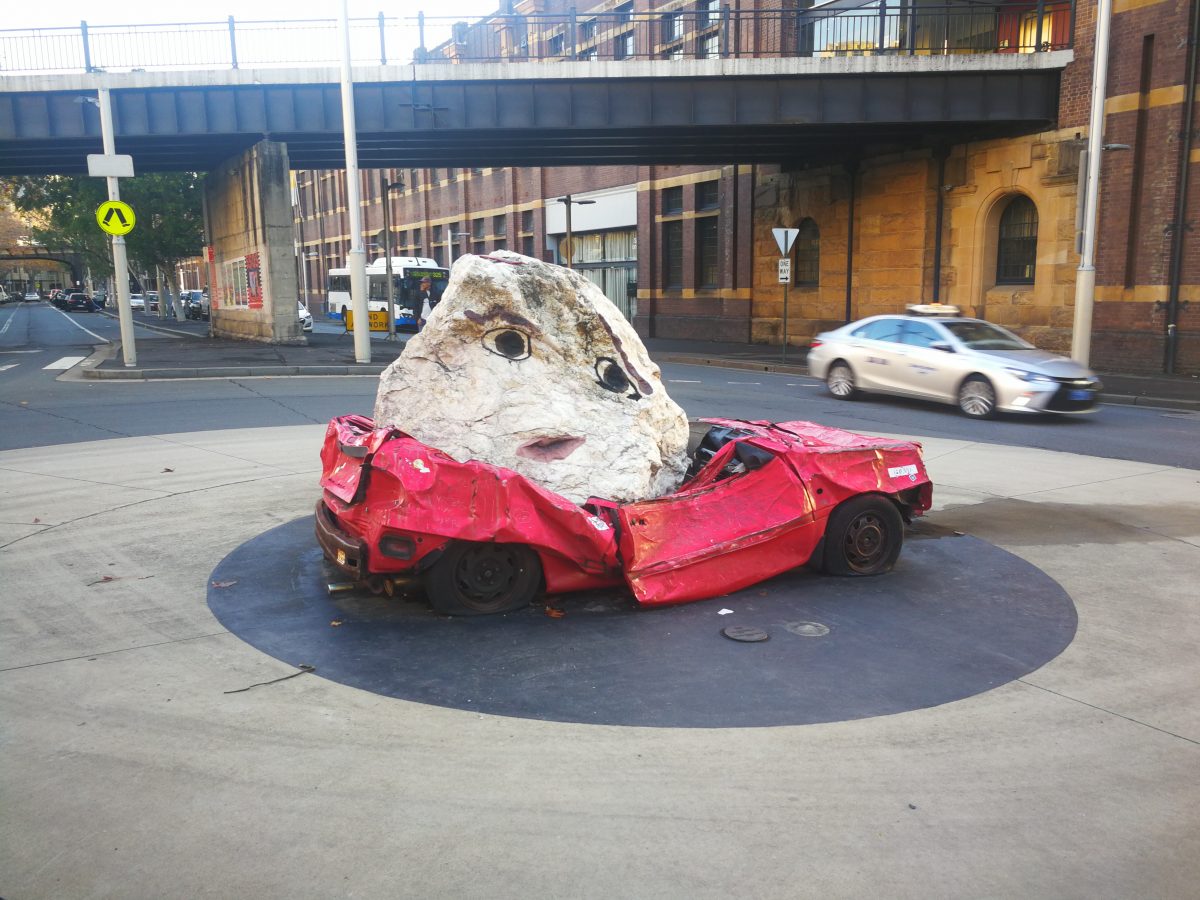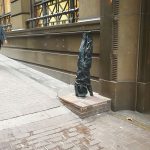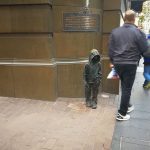Now we’re not saying viewing art indoors is terrible, in many scenarios it is an absolute pleasure and absolutely necessary. Many paintings can’t survive out in the elements, plus there’s always air conditioning. However, viewing art indoors can be intimidating if you’re standing next to critically acclaimed art critics. Not to mention the fear of spilling your Cabernet Merlot on the oil painting in front of you while dodging the art critic’s eclectic hand gestures.
Sometimes it’s better to view art outside.
With that being said, we’ve decided to curate a list of our favourite outdoor artworks in Sydney, pieced together as an easy-to-follow walking guide:
Click here for the Google Maps walking guide part 1 – starting at Elizabeth Street Gallery
Click here for the Google Maps walking guide part 2 – continuing at Still Life With Stone And Car
For the first stop, we recommend getting off at Central Station and walking along Elizabeth Street. Allow 2-3 hours for this walking tour, and plenty of water.
Elizabeth Street Gallery
We start our journey adjacent the Goulburn Street Car Park, the very one that stands above the railway entrance to the city circle. Along the eastern side wall is a photography exhibition showcasing a reality of Australian life. In 2012, the Elizabeth Street Gallery started off as a “guerrilla gallery” installed by Fairfax photographers. There was an expectation it would be torn down, as it was considered illegal, however, Lord Mayor Clover Moore and the City of Sydney loved the idea and sought to make it a permanent exhibition. In 2014, new images replaced the old ones, and they were covered with graffiti-proof laminate while gaining the legal tick of approval by the City of Sydney.
Featured photographers for the current exhibition include:
- Sydneysider Lyndal Irons, sharing her perspective into Sydney’s busiest strip, titled “Parramatta Road“
- Sydneysider Marco Bok, who captured the social world of Sydney’s gothic scene with his collection “Untitled 2006“
- Sydneysider Tom Williams, revealing the inner world of the twin Department of Housing towers in Waterloo, with his collection “Neighbourhood“
- Darwinian Daniel Hartley-Allen, who shared the intimate life of Aboriginal kids in the outback, titled “Kids“
- Brisbanite Brodie Standen, who explored modern-day masculinity in Australia, titled “The Space Between Men“
- Melbournite Josh Robenstone, sharing his view on the changing face of Melbourne’s CBD, called “In the Darkest Light“.
Here, An Echo
It’s a series of 14 seemingly random words and phrases along Wemyss Lane, open to your interpretation. Here, An Echo is designed purposefully so that the reader walks and reads, which can be almost like interpretive dance if done correctly. It was formed by Agatha Gothe-Snape from a long-form project for the 20th Biennale of Sydney, in collaboration with choreographer Brooke Stamp. The result of the research project was this short poem.
For a deeper understanding, read more here.
Frazer Drinking Fountain
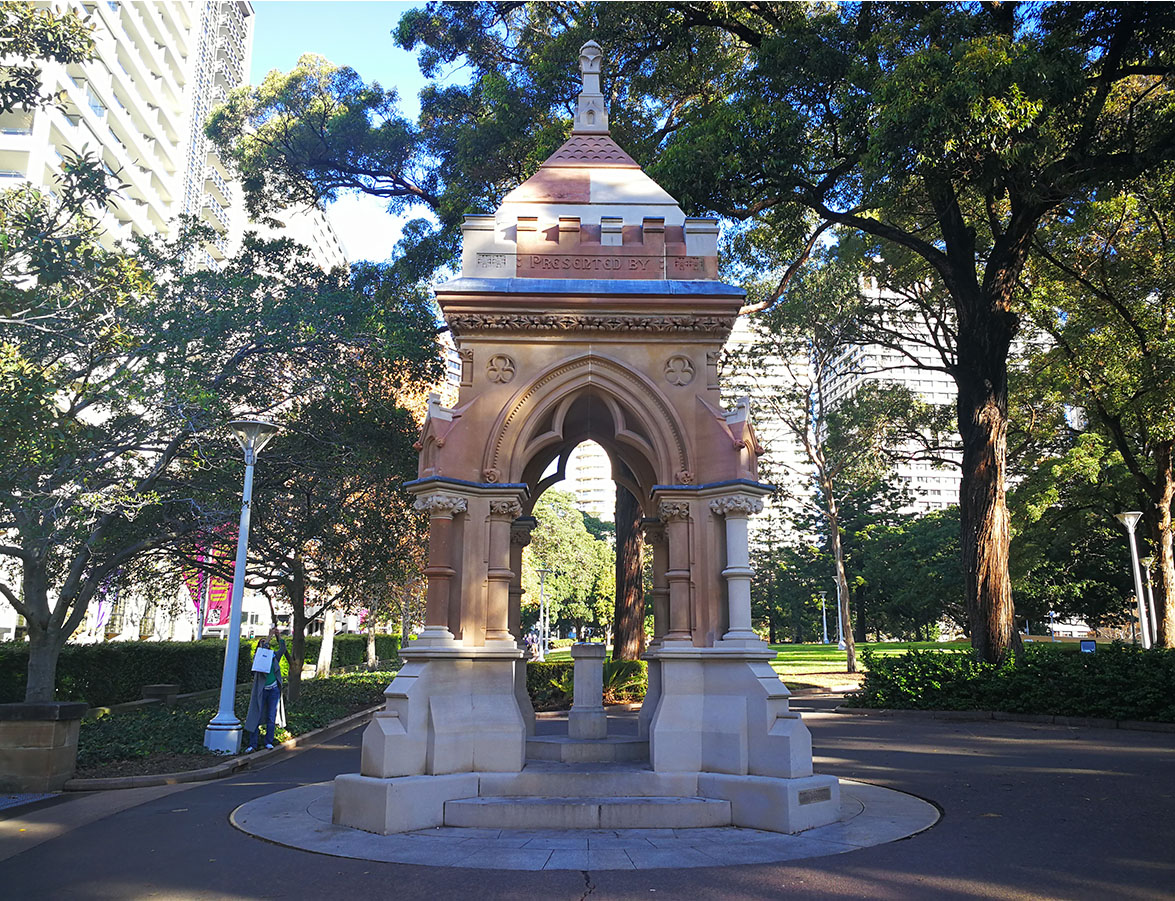
Frazer Drinking Fountain. Image: Chris Kelly
Its original purpose, of course, was for locals to drink from, but it lands itself on our art tour because of both its historical significance and the architecture it shares. It was donated to the city by John Frazer MLC, a businessman and well-known philanthropist, where it sits in the southern end of Hyde Park, adjacent to Sydney Grammar School. The fountain also has a brother, situated immediately north of St Marys Cathedral in the middle of the crossroad. The latter is also in our Google Maps guide.
Both fountains are made of fine Pyrmont sandstone and were installed in 1881 and 1884 respectively. While both fountains were designed by city architect Thomas Sapsord and sculpted by Mittagong sculptor, Lawrence Beveridge, they are very different in style. The fountain in Hyde Park is Gothic in style, while the other (north of St Marys Cathedral) is Baroque in style, and is quite ornate and contrasts with the simple Gothic lines of its brother.
The Archibald Memorial Fountain
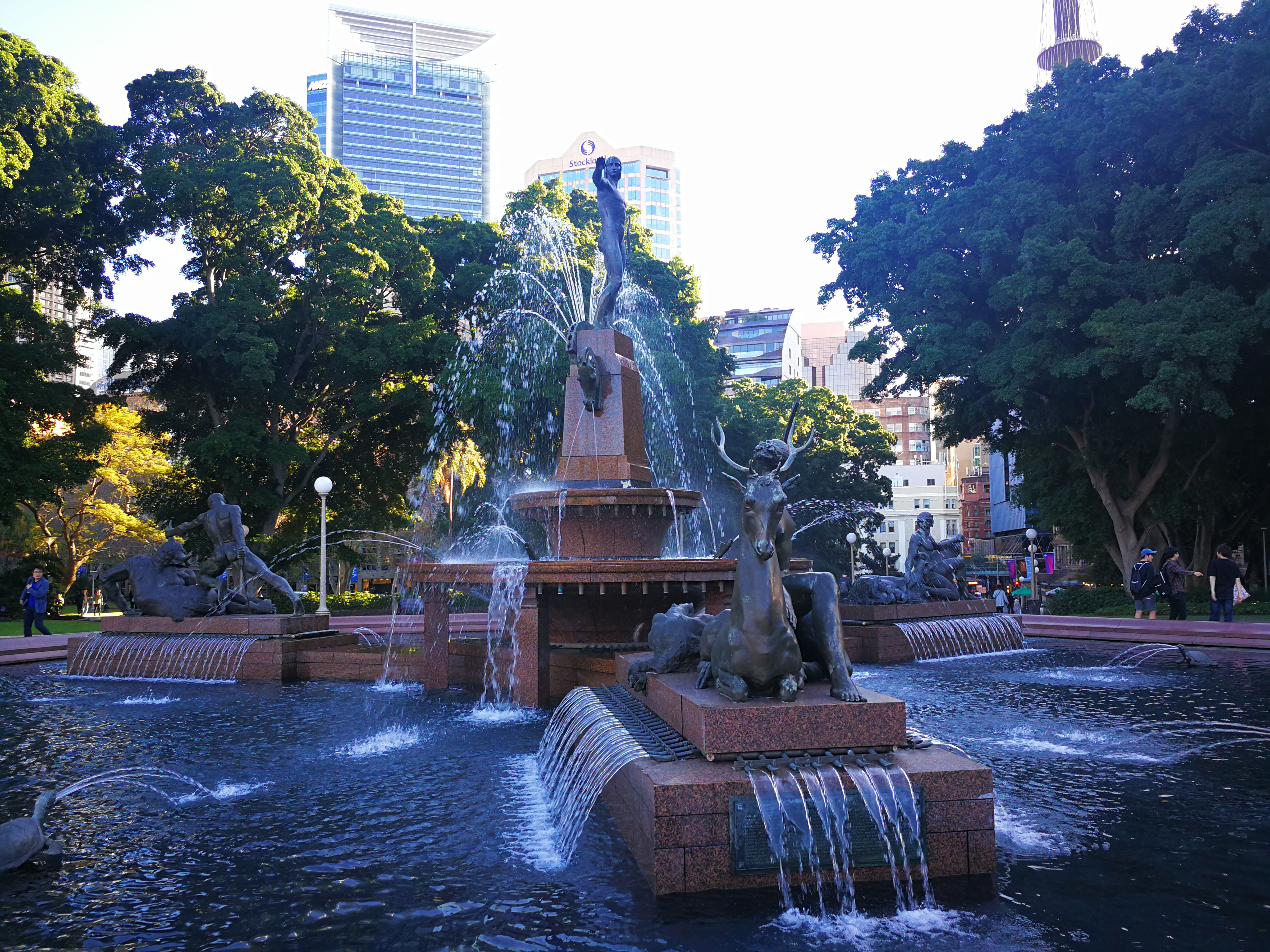
Archibald Memorial Fountain. Image: Chris Kelly
Originally commissioned to commemorate the association between France and Australia in World War I, this fountain also shares the desire for peace. There are a handful of war memorials in Hyde Park, including the ANZAC War Memorial (currently under renovation) and Yininmadyemi, a memorial honouring fallen Indigenous diggers in World War II (better known as the bullets sculpture), but this one does more than just remember our fallen soldiers. The Archibald Memorial Fountain, located at the northern end of Hyde Park, features the central masterpiece of Apollo, giving life to all nature. Surrounding Apollo are three other statues: The first features Diana, bringing harmony to the world; in the second, Pan watches over the fields and pastures; and the third, Theseus conquers the Minotaur, symbolic of sacrifice for the common good.
Il Porcellino
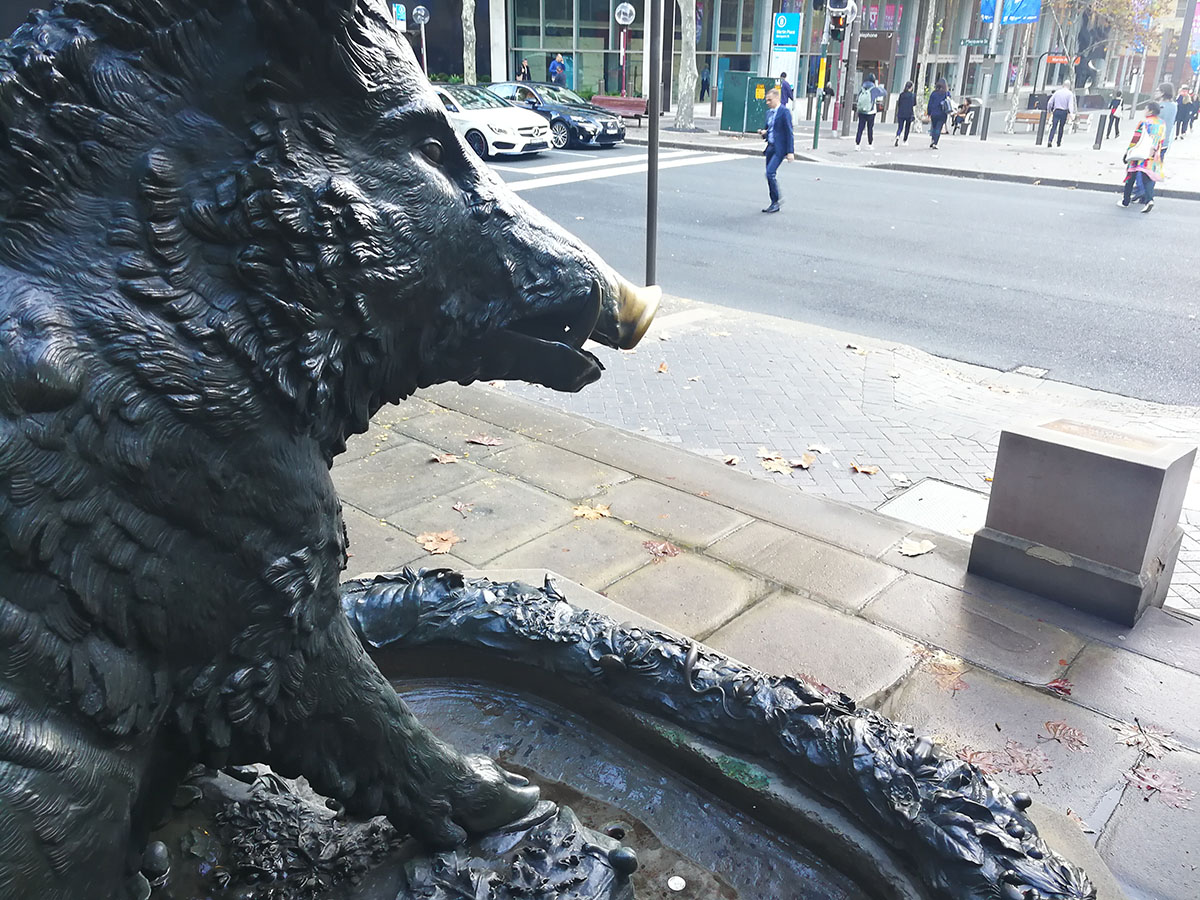
Il Porcellino. Image: Chris Kelly
If we were to tell you this statue relates to philanthropy, would you believe us? Well, guess what, it’s true! This boar is positioned out front of Sydney Hospital and acts as a collection box for the hospital it guards. Il Porcellino is a replica of one that guards a hospital in Florence, Italy, and any passerby wishing to donate can follow tradition by placing their coins into the boar’s gaping mouth and then let it fall into the grate below. They then rub the boar’s snout for good luck.
As you continue on to the next one, keep an eye out for Matthew Flinders and his cat, Trim. They’re added to our Google Maps list.
I STAY (Ngaya Ngalawa)
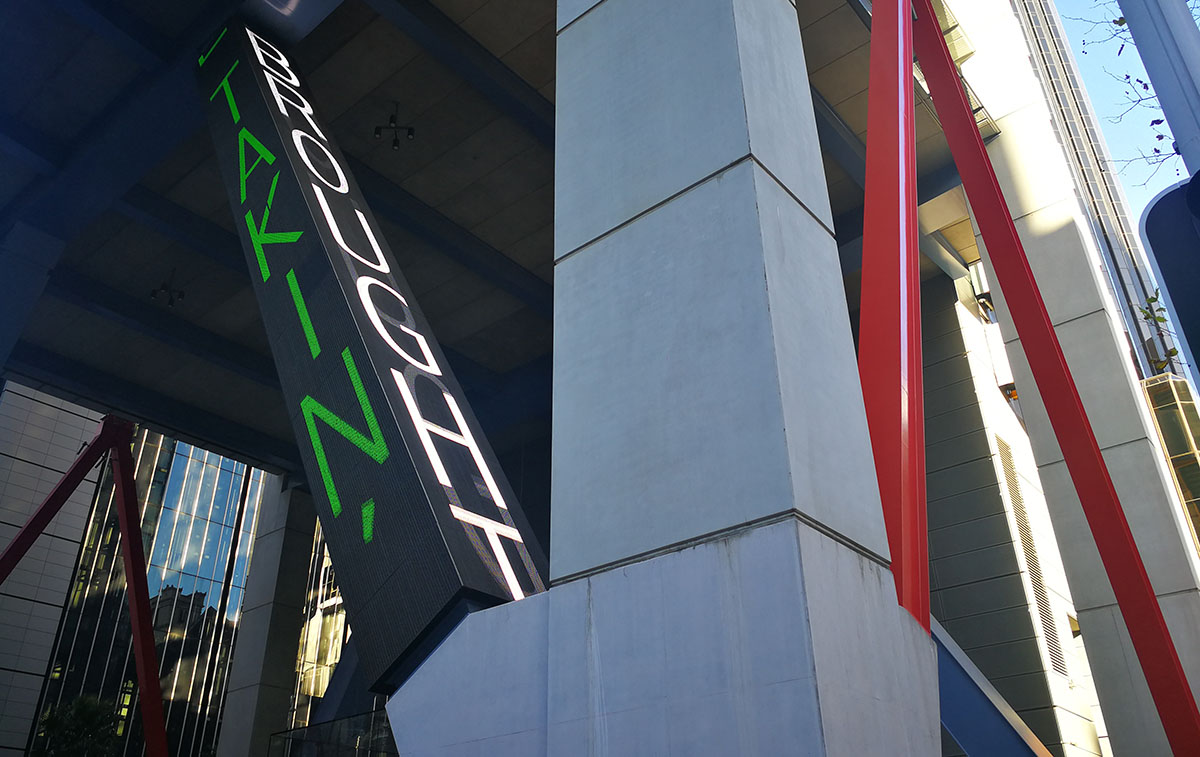
I STAY (Ngaya Ngalawa). Image: Chris Kelly
It’s not a building you easily forget, but you can be forgiven for mistaking one of its pylons as another ‘breaking news’ timeline. This artwork is located on the corner of Hunter and Elizabeth Streets, sharing songs, poems, stories, autobiographies and other texts by Aboriginal Australians and Torres Strait Islanders. They have been curated and displayed by Jenny Holzer, a writer who shares her work in the outdoors.
“The text I chose was influenced by a people’s history, but the themes, such as love and survival, are universal,” Jenny Holzer said on her website. “The first person voice in much of the writing makes the artwork alive and immediate, accessible to many. Writing by Aboriginal and Torres Strait Islander authors was most compelling; it illustrates that what happens to individuals and groups, happens to society. The human themes here make this public space integrate and honour the personal.”
The Distance of your Heart
https://vimeo.com/158415330
Hidden through Bridge and Grosvenor streets and through the refurbished Kent Street underpass are 60 handmade bronze birds. Artist Tracey Emin said these birds represent distance and homesickness. How do you express loneliness without words? Her answer is with a bird. They are fleeting, like migration. They can holiday wherever they please. But they are living things, delicate and fragile. Just like us.
Memory is Creation without End
Within the Royal Botanical Gardens is a graveyard of past relics from demolished buildings and structures, like the old Pyrmont Bridge. Take a walk through memories of Sydney and try and see where the past has influenced the future, and how history is just a litter of stepping stones leading towards a future that seeks new, but can never shake the old. It is located west of Circular Quay Station, and immediately north of the entrance to Sydney Harbour Tunnel.
Intermission
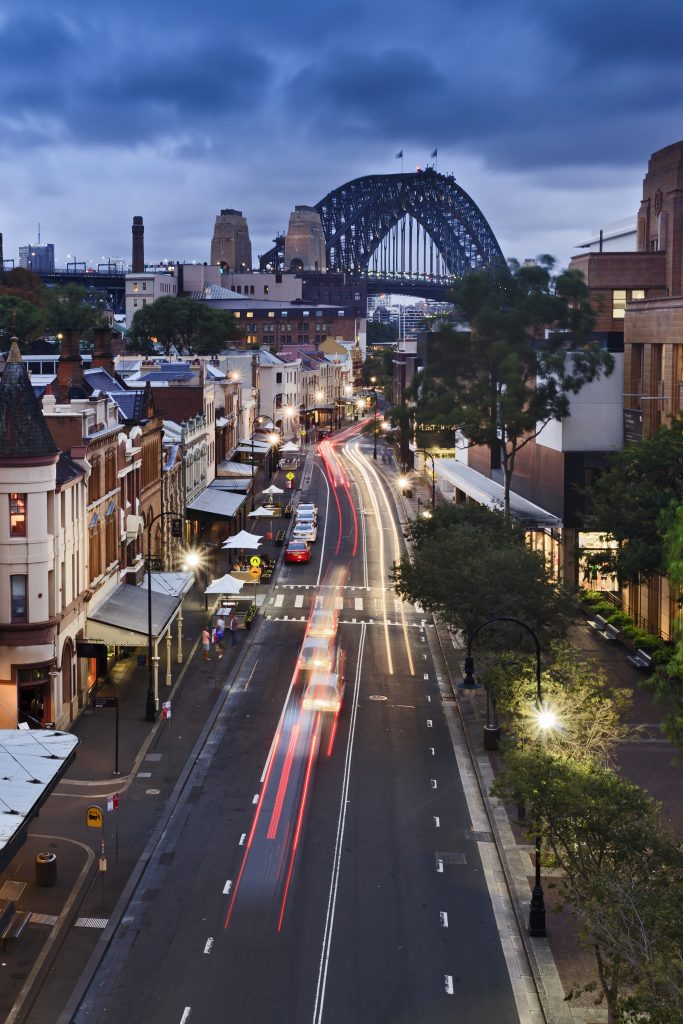
Circular Quay and The Rocks boast some of Sydney’s greatest culinary experiences, and so it’s here where we rest before the next leg of our excursion. If you’re like us and wish to escape the hordes of tourists, then The Rocks is your safe bet. Treat your taste buds to some Mexican at El Camino Cantina or fill up on German cuisine at Munich Brauhaus. It also gets you closer to the next artwork, Still Life With Stone Car, which is a little way out from the rest, but totally worth seeing. If you’re not up to it physically, then continue at Tank Stream Fountain.
Still Life With Stone & Car
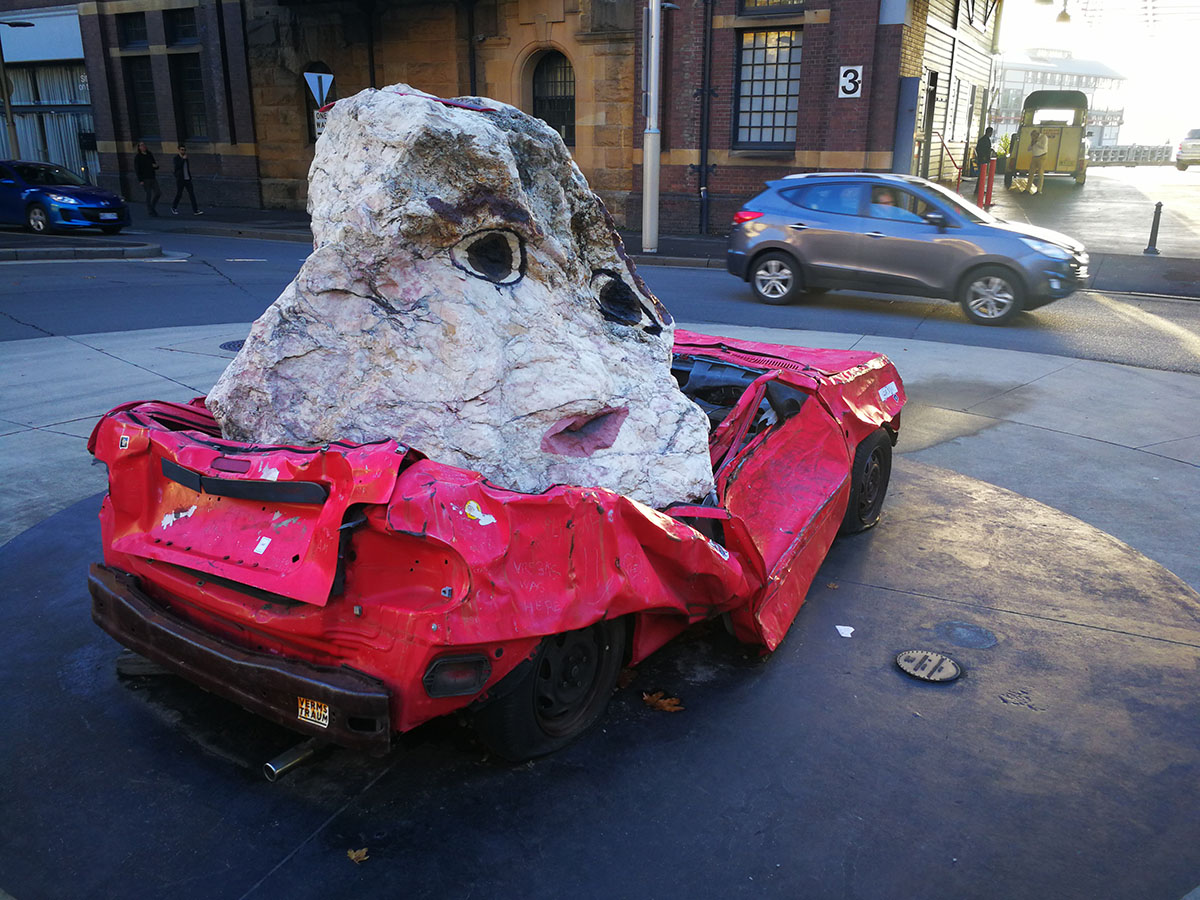
Still Life With Stone And Car. Image: Chris Kelly
A general consensus would find that a 1999 Ford Festiva hatchback crushed by a two-tonne quartz boulder featuring a crudely-drawn face may not be appropriate for the centrepiece of a roundabout. But that’s because they’ve yet to see its artistic significance.
This artwork was created by Arkansas-born Berlin-based artist Jimmie Durham, where the car was crushed on the forecourt of the Opera House in 2004. In 2006, it was placed in its now permanent position on a roundabout along Hickson Road. This particular artwork is part of Walsh Bay’s Sculpture Walk, which also features a free online audio tour. Click the preceding hyperlink for more details. You might as well undertake it while you’re there. It is a bit of a walk to the next one.
Also, take care viewing this piece. It is in the middle of the road, after all.
Tank Stream Fountain
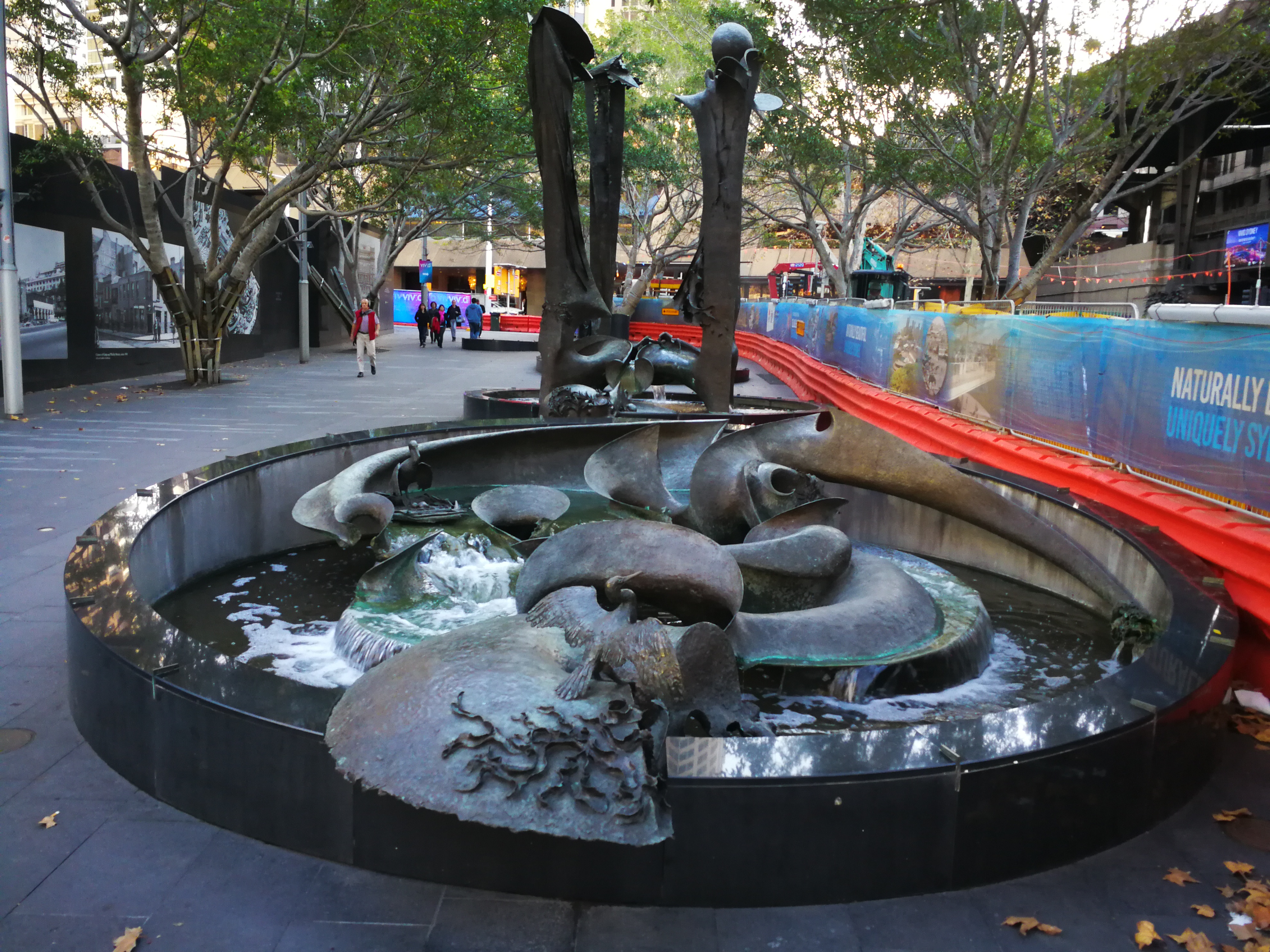
Tank Stream Fountain. Image: Chris Kelly
If you ignore the tram-line being built nearby, you can truly appreciate this fountain. It was built in 1981 to commemorate the union between the Sydney Morning Herald and Sydney’s European history. Its bronze template features metaphorical and abstract forms through a collection of pools. They are all connected to the European settlement’s first water supply. It is located on the corner of George and Alfred Streets.
Interloop
Hovering above the newly installed four-lane escalators of Wynyard Station are the old escalators that had served Sydney for 80 years. They were the first escalators in Sydney, and artist Chris Fox, as well as Transport for NSW, could not let them decompose into oblivion.
Yes, we know, it’s not exactly “outdoor”, but the historical significance makes it worth adding to this list. You can find this artwork at the bottom of the escalators at the York Street entrance.
The Youngsters
- Youngster artwork. Image: Chris Kelly
- Youngsters artwork. Image: Chris Kelly
Even a longstanding Sydneysider could be forgiven for overlooking these two sculptures. They almost blend in, not just with the scenery, but the moving crowd around it. They evoke the true essence of youth and naivety while bringing forth modern stereotypes. They are the hooligans that elderly people tend to fear, that the middle-aged tend to secretly hate, and that the young adults seek to challenge. But when you really look at them, they are no less human than anyone else. We’ve all been that young kid with the hoodie. We’ve all been that youngster who yearned to challenge the status quo. It’s simply relatable.
These sculptures were created by Caroline Rothwell and were acquired by the City of Sydney. It remains a permanent fixture at the intersection of Barrack and George Streets.
Forgotten Songs
Extinction and forced migration became the unfortunate result of the European settlement on Sydney Harbour. The sounds of 50 birds that once inhabited the CBD can now only be heard through the speakers adjacent Sydney Recital Hall in Angel Place, while overhead 50 birdcages of all shapes and sizes remain empty. The sounds change throughout the day and into the evening. You can read more about it here.
To Sail, To Stop
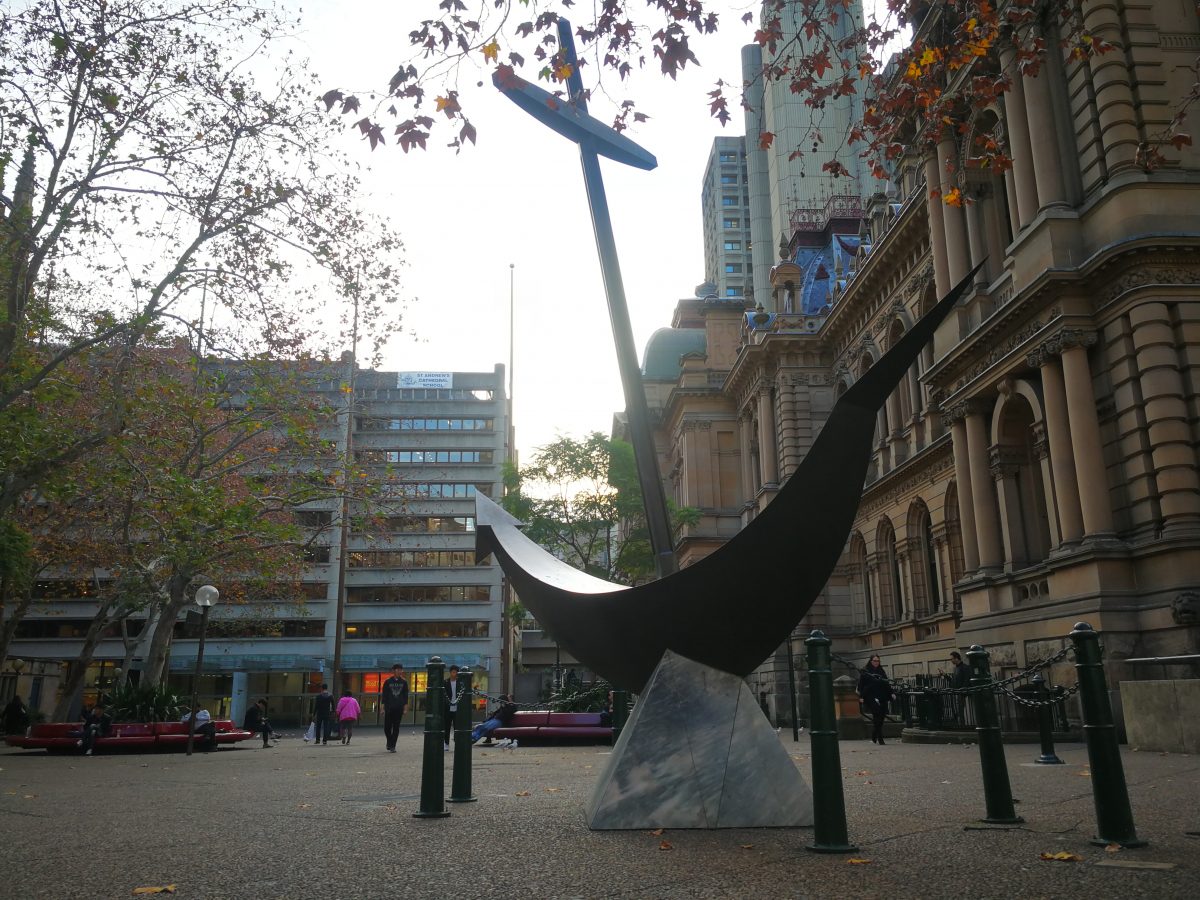
To Sail, To Stop. Image: Chris Kelly
It looks like an anchor, but can also be construed for a ship without sails, and it’s situated next to Sydney Town Hall. To Sail, To Stop marks the long association between the Chinese community and the City of Sydney, while conveying the story of the First Fleet. Its plaque reads “This statue has been made with the support of the Chinese Community to mark their contribution since the early days of the City. In a wider sense, ‘To Sail, To Stop’, symbolises all those who have travelled and who have chosen to stay.”
Spanish Quarter Steps
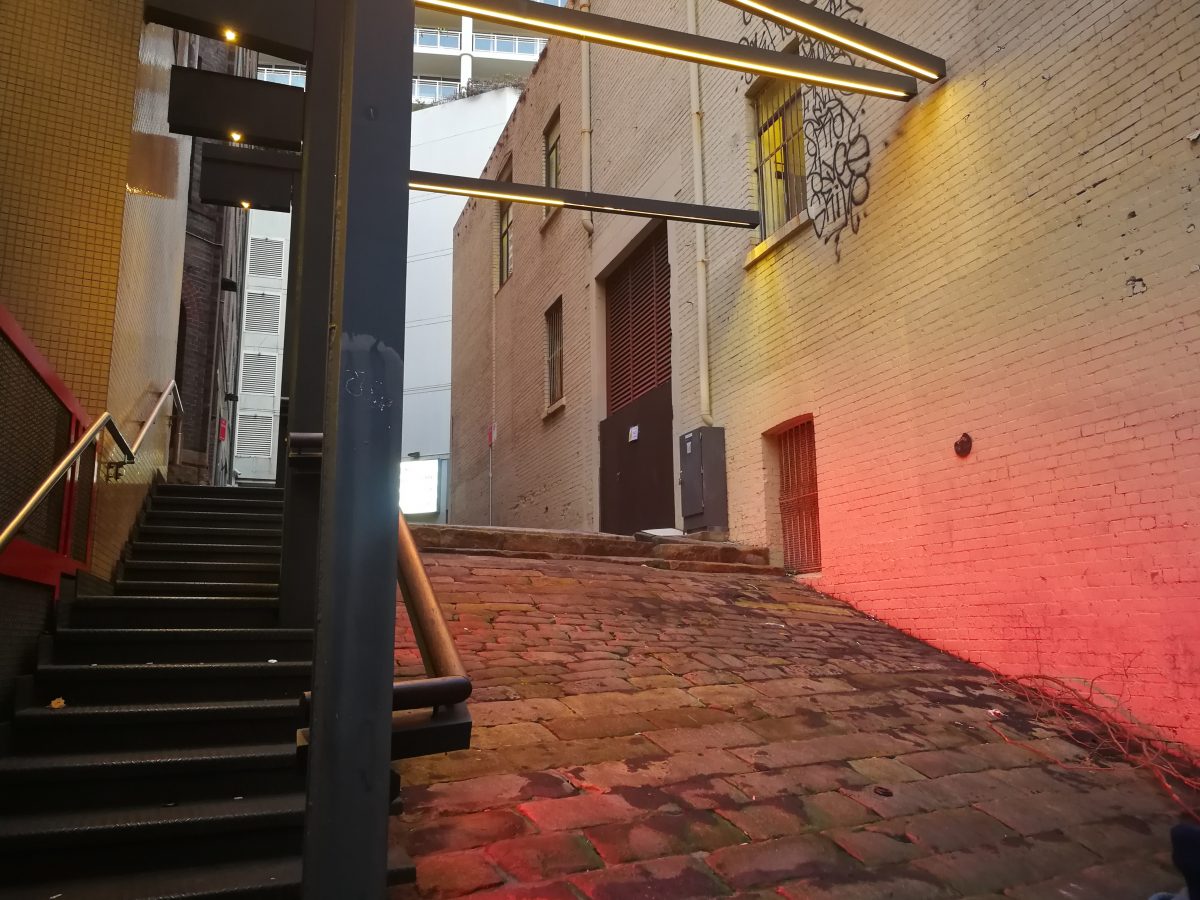
Spanish Quarter Steps. Image: Chris Kelly
This public staircase acts as a thoroughfare while also providing a window into the history of Sydney’s Spanish Quarter and its unique connection to Chinatown. The cobblestones were once laid for accessibility, but not for cars, and not just for people. Can you ever imagine a horse tackling this steep embankment? Well, it once happened. It’s also worth noting the contrast between the historical cobblestone laneway and the modern metal steps that hover beside it. Check it out at 368 Sussex Street.
In Between Two Worlds
Incorporating the elements of earth, wind, water, and fire (as well as Chinese and Aboriginal culture) comes this spectacular laneway art by Jason Wing. It juxtaposes the motifs found throughout Chinese and Aboriginal art. The elements of earth, wind, water, and fire are said to have their own spirits, something believed by both Chinese and Aboriginal cultures.
By day, this laneway reveals blue clouds and silver figures, while by night it is lit up under blue illumination. It’s located in the laneways of Little Hay Street, Factory Street, and Kimber Lane.
a life
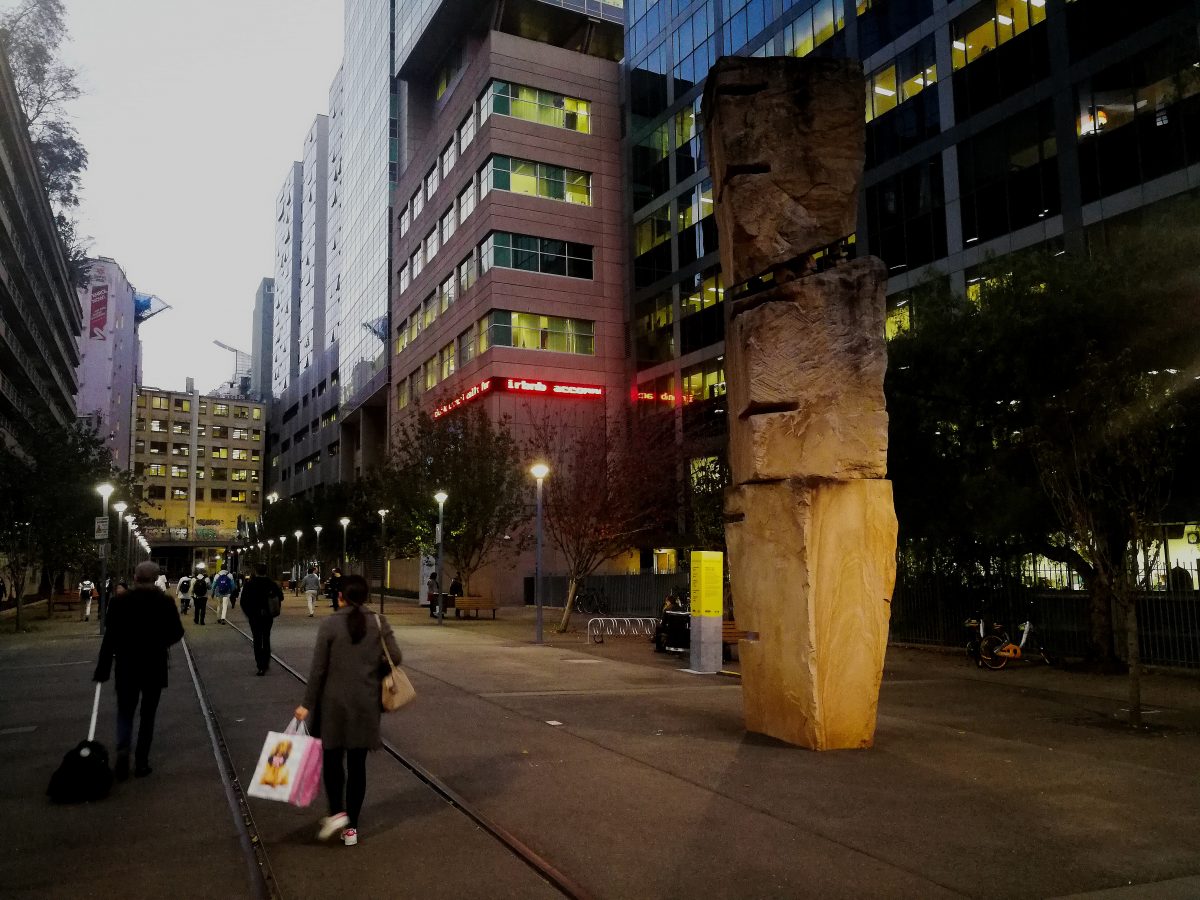
a life. Image: Chris Kelly
“A 25-tonne stone quarried as a single block now stands upright in three distinct segments, openly carrying the scars of the work’s making,” writes the sculptor, Gary Deirmendjian, on his website. “The work in the whole reads as an upright figure with head and torso twisted above the hips, found standing next to a rail line in the midst of a highly planned urban setting.”
There’s a nice contrast here with a still life standing in one of Sydney’s most important thoroughfares. You can still see the tracks cutting along the walkway, where they once travelled all the way to Darling Harbour. It’s “The Goods Line”, and the stone statue next to it seems to gaze upon the glistening steel tracks for inspiration. Seemingly biding its time.
Material World Lightboxes
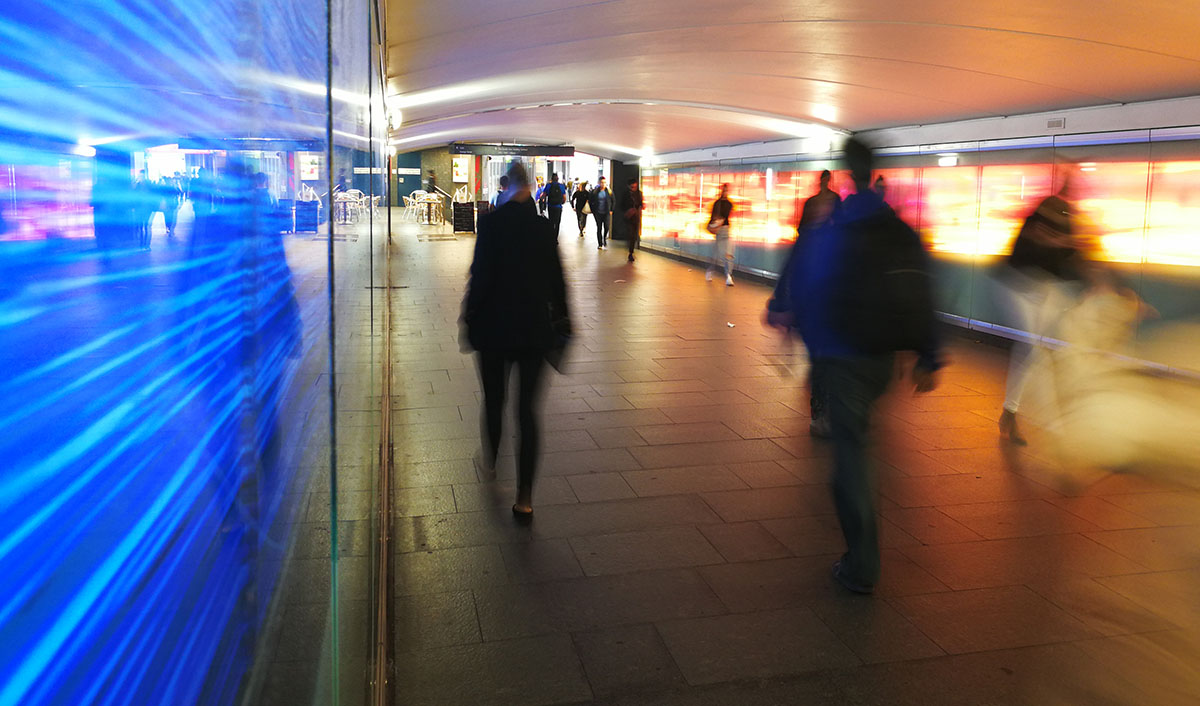
Material World Lightboxes. Image: Chris Kelly
We end our artistic tour of Sydney at a spot where many have walked. It’s a bustling thoroughfare connecting UTS, ABC and Sydney TAFE with Central Station. You yourself may have walked past it without even batting an eyelid. Are you curious about what it really means? Well, here goes:
Material World Lightboxes emits the elements of earth, water, fire, and air, and is split between the below-ground light boxes and the above-ground lighted towers. Artwork creator Marylin Fairskye wanted to “echo the idea of the vanished gateway into the city”. It is not designed as art to stand still and peruse but to perceive as you walk on past. It plays with your perception as glides past your peripheral, and this illusion depends on your speed and the moving bodies around you.
Have you ever walked past and thought you’d seen a face? Well, you surely have.

